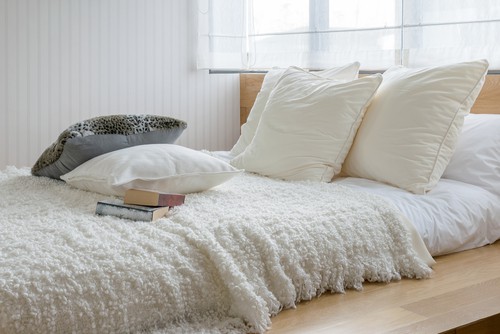Everyone would agree that a blanket is an important asset for keeping you warm and cozy especially at night when you are asleep. However, blankets accumulate debris and dust mites over time. The dirt may spell doom to your health and your overall well-being because it may lead to allergic reactions and other health related issues. What do you need to do then to avoid being a victim of circumstance? Keeping your blanket clean is the only ultimate solution. Moreover, cleaning your blanket increases its lifespan. You can either opt for commercial laundry services or clean them at home. In this article, we will look at the best cleaning practices that will guarantee you 100% results. Read on:
Method
1. Step one: Preparation
This is the first step in the cleaning process. Remember, your blanket has a label with a set of instructions that will guide you through the cleaning process. It is important to follow the instructions to the letter. However, it is important to determine whether it is the right time to wash your blanket because they don’t need to be washed every day.
Additionally, if your blanket has a single stain, there is no reason of washing the entire. During preparation, it is also important to check whether your blanket has any holes. If any, you must remedy them to narrow the chances of widening them as you wash.
The last step in preparation is to remove any stains on your blanket. Some amount of non-detergent solution, paste or carbonated water can be used to remove the stains. It is recommended to refrain from use of bleaching solutions.
2. Step two: washing the blanket
This is where the actual cleaning for removing debris and other dirt comes in. To do so, follow the following steps;
· Insert your blanket into a washing machine in your home making sure that it is distributed evenly in the machine. Ensure that your washing machine is large enough such that it can give enough room for easy cleaning.
· Choose the water temperature that is optimum for washing your blanket. The optimum temperature is usually labeled on the blanket sticker. If you don’t have a dryer, you can use hot water to ensure that the dust mites are dead.
· Add extra rinse cycle if necessary. After that, use some amount of mild detergent. Do not add excess detergent because this can lead to formation of too much foam.
· Rinsing the blankets for more than twice ensures that all the soap is eliminated. Remember, if you have a very sensitive skin, soap may irritate you.
· For effective cleaning and balancing of the load, you can add clean white tennis balls. However, the tennis balls must go into the wash within the selected settings.
3. Step three: Drying the blanket
This is a very important step that needs your attention. If you overlook this step thinking that you are done, you can do more harm to your blankets. For best drying results:
· Put thee cleaned blanket on your dyer using the tennis balls before start drying it. Note that it is important to use low heat setting to dry the comforter. If you want to kill dust mites, you can apply high heat. Remember, tennis balls do not tolerate extremely high heat settings.
· Make sure to fluff your blanket regularly as you dry it. The average time to fluff your blanket is after every hour. You will be required to remove it from the dyer, fluff it and put it back. This ensures that the blanket is properly aerated for even drying.
· Hanging the blanket outside the house- this is the last step as far as drying is concerned. A dry and sunny surrounding is ideal for perfect drying results. Remember, if the blanket is thoroughly dried, the chances of mildew are reduced.
Alternatively, if your find that it is extremely sunny and warm outside, you can forego the dyer and hang your blanket outside to dry. If you take this alternative as an option, you should ensure that the blanket is rotated 900 so that it dries evenly. On the other hand, if the weather is not conducive outside, you can hang your blanket in a well-ventilated but cool and dry place.
It is important to avoid drying your blankets entirely with the help of a machine. Drying them outside guarantees the best results.
Additional tips for cleaning your blankets
· Always vacuum your blankets regularly. This is important in removing any dust particles of lint that may have accumulated on them.
· For aeration purposes, always hang your blankets on a clothesline in an open dry and cool place to ensure that they remain fresh and soft.
· Refrain from dry cleaning electric blankets. Remember, cleaning solvents damage the wiring of these types of blankets. Electric blankets should therefore be washed.
· If your blankets have larger holes, it is important to extend ultimate care to it to ensure that they doesn’t widen to the worst. However, if the holes are small, you can mend them before washing to avoid extra damage.
· Always refrain from using hard water to wash your blankets. Hard water makes your blankets to have a rough feel. It is therefore important to add a water softener to the water that you are using to ensure that the blankets are soft and comfortable to use.
· If you realize that your blanket is having an extra coating that makes it rough, add another rising cycle to remove all the detergent. If you don’t rinse your blankets properly, they will be uncomfortable to sleep under.
· You should refrain from using dryer sheets on those blankets that are soft. This kind of sheets leaves some coating on the blankets which then make them to have a rough feel.
Final verdict
It goes without saying that a dirty blanket can make you sneeze and create unbearable discomfort while sleeping under it. Therefore, it is important to clean it regularly once you realize that it has accumulated dirt on it. Remember, blankets come in different qualities and this obliges you to read the label of instructions on the specific blankets before embarking on the washing process. Maintain cleanliness!


